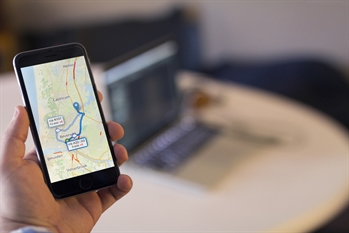Case study IJmondverkeer.nl: website with route and travel time updates
The ijmondverkeer.nl website was developed to give travellers real-time information on journey times and alternative routes during the renovation of the Velser tunnel in the IJmond region. The travel information on the website is shown for routes to busy destinations such as the city centre of IJmuiden or Beverwijk.
In addition, companies were able to apply for a customised version of the website. That way, they could display information about major routes to their specific target groups through their own communication channels (in-house website, intranet, screens at entrance, etc.). Uniquely, when the Velser tunnel closed on 15 April 2016, the website automatically adjusted the travel information displayed to the new situation on the temporary road network that had been constructed before the closure of the Velser tunnel.
Background and aim
On 15 April 2016 the Velser tunnel was fully closed to traffic for a nine month period. To keep the IJmond region accessible, Rijkswaterstaat constructed a temporary road network. It also launched a special website (ijmondverkeer.nl) to inform road users and other interested parties of the new roads, alternative routes and travel times. There was demand for this in particular from businesses, road hauliers and busy locations in the IJmond region.
By developing this instrument, Rijswaterstaat was able to guarantee to all these parties that correct travel information would be made available immediately after the closure of the Velser tunnel. This was something that the market was not yet able to do in 2016. Existing travel information services were not (at the time) able to meet the demand from the region.
Scope and effect
Measurable reach:
More than 150 businesses applied for a customised version of the website. Some of these subsequently implemented the website on their own website, in news bulletins or on screens at road haulage scheduling departments. The website was also disseminated via local media among the residents of the IJmond region.
Measurable effect:
An effect measurement based on the number of page views was performed via Google Analytics (note: displays on e.g. screens or website-integrated ‘iframes’ were not included in the count):
- shortly after the closure of the Velser tunnel: 6,500 unique views per day
- gradually decreasing to several hundred per day
- total number of unique users: over 45,000
Other effect:
The development and deployment of this measure has been partly responsible for the increase in support for the road works on the Velser tunnel, while the original resistance has been turned around, and stakeholders now have a positive, pragmatic attitude. It also gave road users a handy tool to familiarise themselves with the complicated temporary infrastructure.
Points for attention
- Stakeholder support: involve stakeholders in the development of the website to ensure the website is aligned with their wishes. This increases the chance of them actually using the website and communicating the information to their target groups.
- Dissemination of information: promote the website via the existing local channels instead of via Rijkswaterstaat. Local branding resonates more with potential users.
- Development: the ijmondverkeer.nl website was purchased from three specialised developers: Innovactory for the front-end, Simacan for the back-end and TomTom for Floating Car Data. Make sure that the interfaces between these parties are seamlessly coordinated.
- Procurement: buying travel information as a mobility measure is not (yet) routine practice at Rijkswaterstaat. The procurement process must therefore be carefully managed and planned well in advance.
- Customisation: every project is different. Choose your travel information solutions on a case-by-case basis. Due to the unique temporary infrastructure around the Velser tunnel, the development of ijmondverkeer.nl was a logical and effective measure, but that is certainly not always the case.
- Market versus the authorities: in the specific case of the closure of the Velser tunnel and the temporary road network, Rijkswaterstaat decided to have ijmondverkeer.nl developed under its own auspices. This is an exception to the rule. Each individual project must therefore be carefully assessed to determine whether this approach is necessary and justifiable. Another factor is that the travel information market is developing fast. Monitor this closely and always check the latest market offerings first.
- Case study Modifying (online) maps for temporary adjustments to the road network during the renovation of the Velser tunnel: there is a clear relationship with the measure described in the case study concerning the adjustment of existing map material. The synchronous implementation of these two measures and the lack of offerings from the market were important considerations in the decision to develop ijmondverkeer.nl. The two measures also complemented each other in the overall package of project measures.
Can the measure be deployed more broadly?
This measure cannot be copied one on one for broader deployment as the Velser tunnel closure (including the temporary road network) was a unique situation. Due to the drastic changes to the road network, it was not yet possible in 2016 to entrust a measure of this type completely to the market. In this specific case we made a one-off decision to develop the website ourselves.

